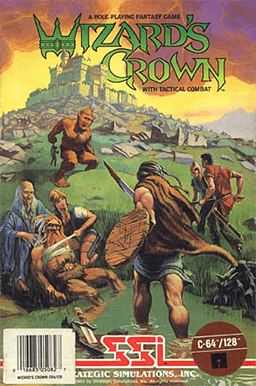Wizard's Crown
| Wizard's Crown | |
|---|---|
 | |
| Developer(s) | Strategic Simulations, Inc. |
| Publisher(s) | Strategic Simulations, Inc. |
| Designer(s) | Paul Murray, Keith Brors |
| Platform(s) | Atari 8-bit, Atari ST, IBM PC, Apple II, Commodore 64 |
| Release date(s) | 1985 |
| Genre(s) | Role-playing video game |
| Mode(s) | Single player |
Wizard's Crown is a 1985 top-down role-playing video game published by Strategic Simulations, Inc. (SSI).[1] It was released for the Atari 8-bit, Atari ST, IBM PC, Apple II and Commodore 64. Its sequel, The Eternal Dagger, was released in 1987.
Gameplay
Wizard's Crown is a detailed game for its age. While the graphics are typical for games of the era, the extensive combat, injury, character advancement, and magical equipment systems rival those of games made ten years later. The object of the game is to rescue a magical crown from Tarmon, a wizard who sealed himself and the crown in his laboratory 500 years previous.
The video game design and programming was done by Paul Murray and Keith Brors, game development by Chuck Kroegel and Jeff Johnson, and the rulebook created by Leona Billings.
Wizard's Crown features a detailed tactical combat system, which influenced SSI's design of the subsequent, highly successful AD&D Gold Box series. For instance, shields block attacks only from the front and left (shielded) side, and not from the rear and right (unshielded side). Spears can attack two squares away, Flails ignore the defender's shields, and Axes have a chance of breaking shields.
There is an option for 'quick combat', with regular combat taking anywhere from 5 to 30 minutes (or more) per encounter.
The class system is based on a point buy system, with the unique feature of 'buying' classes and skills using Intelligence points. The classes are Thief, Ranger, Fighter, Priest and Sorcerer, each possessing a distinct set of skills and any of which can be combined together into a single character. Up to eight characters could be created in a single party.
Experience is spent directly on skills, attributes and life points. When a skill level is very low each fraction of experience spent developing it can result in a rise from 1 up to 8 skill points; this upper limit gradually lowers until it's very hard to get any increase at all past the 100-skill points mark. The maximum skill level is 250.
The game is also memorable for its magic weapons, for example, the Storm Longsword or Doom Battleaxe. They are three special series of weapons which can be enchanted to become progressively more powerful:
The 'Magic' series of weapons does pure magical damage ("injuries") and progresses under the names of 'Magic, Frost, Flaming, Lightning and Storm'.
The 'Plus' series of weapons cause extra bleeding, which would cause an opponent to pass out ("The opponent lies unmoving") but not die outright. For example, if all player characters pass out from excessive bleeding in a battle, you lose the battle, but are given a chance to heal them up in camp afterwards. These weapons are designated with "+1, +2, +3, +4, +5".
The 'Life Blast' series of weapons are the most powerful in the game. They do direct damage to life points, and a character who is taken out by these weapons is killed; you cannot revive them except with a resurrection spell. These weapons progress with the names 'Dark, Doom, Soul, Demon and Death'.
Reception
Wizard's Crown was SSI's second best-selling Commodore game as of late 1987.[2] Compute! favorably reviewed Wizard's Crown, describing it as "probably the most unusual fantasy game to hit the market in some time". Citing its graphics and detailed combat, it stated that the game "that will excite and challenge even the most seasoned veteran of fantasy warfare".[3] Computer Gaming World admired the game's use of injuries and bleeding in simulating combat. However, the review also felt there was far too much emphasis on hack and slash, with only a few trivial puzzles and almost no interaction between the party and anyone else beyond buying, selling, and killing.[4] A.N.A.L.O.G. was more positive, calling the Atari version "superb ... a true gem, an addictive game which you'll find yourself playing day in and day out".[5] The game was reviewed in 1986 in Dragon #114 by Hartley and Pattie Lesser in "The Role of Computers" column. The reviewers "recommend this offering as one that truly presents a most positive view of fantasy role-playing as played on a computer system."[6] In a subsequent column, the reviewers gave the game 4 out of 5 stars.[7] Antic 's review was mixed, stating that Wizard's Crown "throws in a few new tricks of its own" but "is mostly old wine in new bottles". The magazine concluded that "Wizard's Crown is okay. But I probably would have enjoyed it more if I felt that I was really controlling the characters—not just watching random-number generators at work."[8]
References
- ↑ Barton, Matt (2007-02-23). "Part 2: The Golden Age (1985-1993)". The History of Computer Role-Playing Games. Gamasutra. Retrieved 2009-03-26.
- ↑ Ferrell, Keith (1987-12). "The Commodore Games That Live On And On". Compute's Gazette. pp. 18–22. Retrieved 24 January 2015. Check date values in:
|date=(help) - ↑ Trunzo, James V. (August 1986). "Three Fantasy Games For Commodore And Apple". Compute!. p. 60. Retrieved 9 November 2013.
- ↑ Scorpia (Sept–October 1986). "Wizard's Crown". Computer Gaming World. pp. 24–25. Check date values in:
|date=(help) - ↑ Panak, Steve (1986-12). "Panak Strikes". A.N.A.L.O.G. p. 97. Retrieved 7 July 2014. Check date values in:
|date=(help) - ↑ Lesser, Hartley and Pattie (October 1986). "The Role of Computers". Dragon (114): 72–76.
- ↑ Lesser, Hartley and Patricia (October 1987). "The Role of Computers". Dragon (126): 82–88.
- ↑ Bernstein, Harvey (April 1987). "Wizard's Crown". Antic. p. 47. Retrieved 26 January 2015.